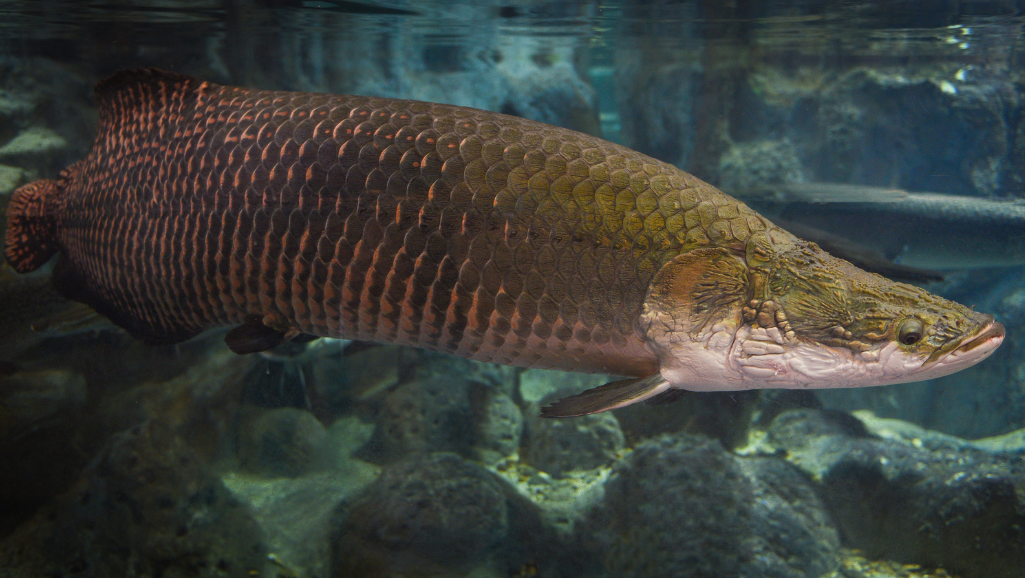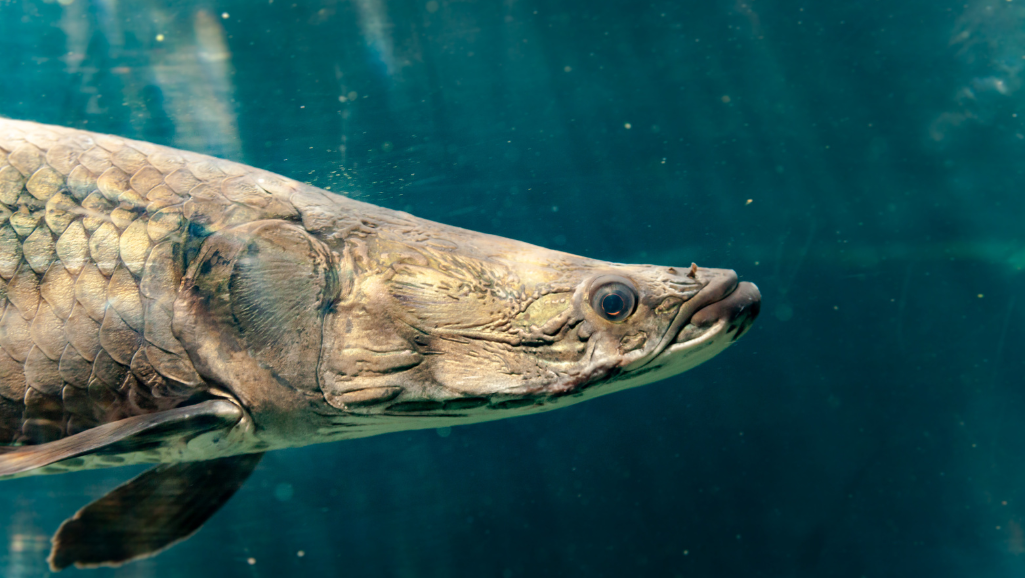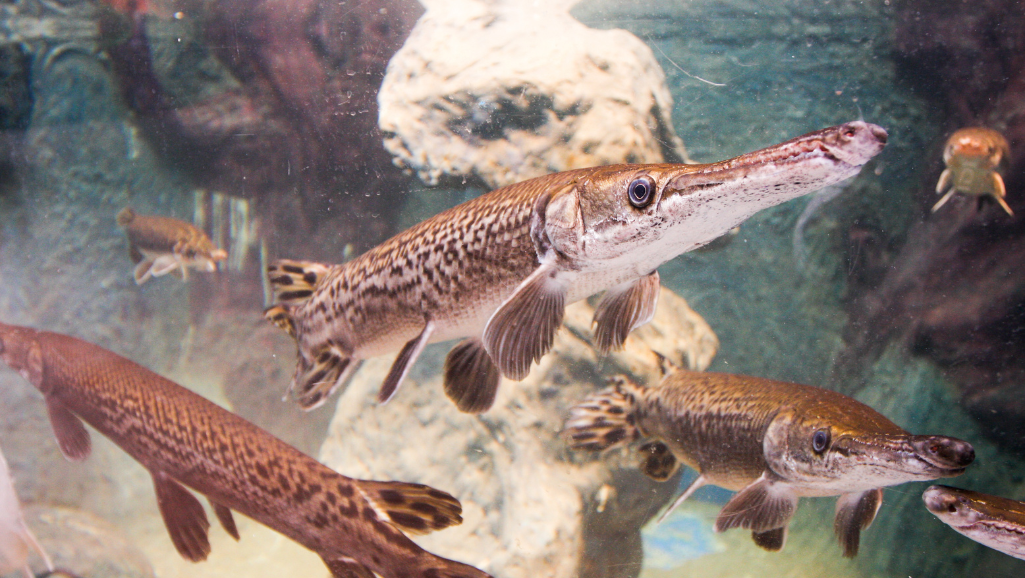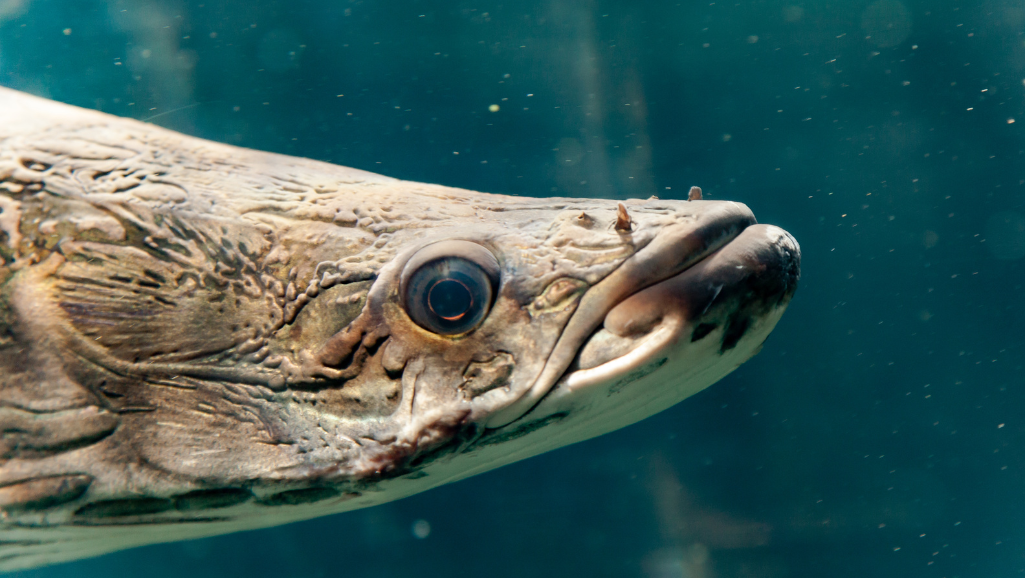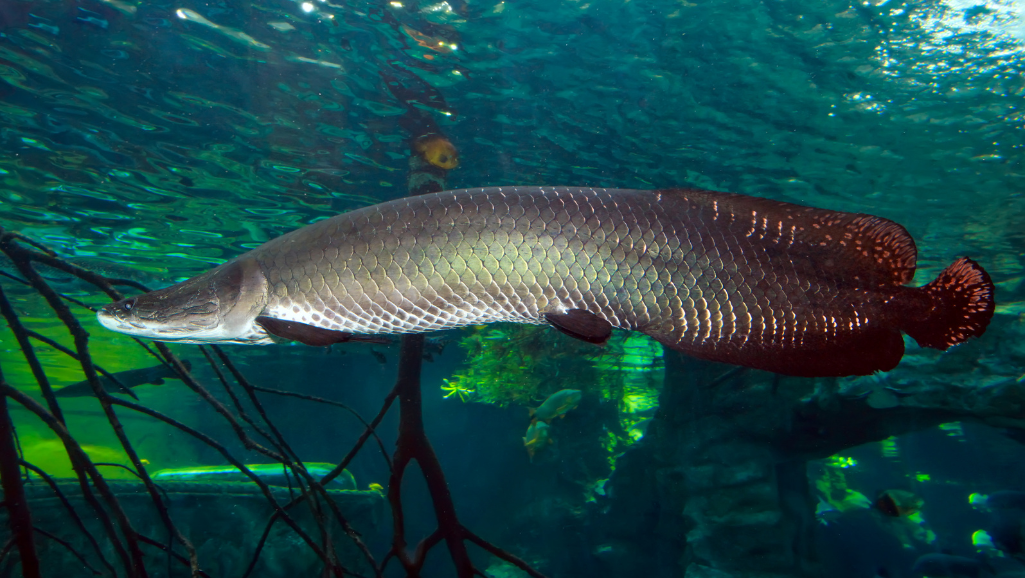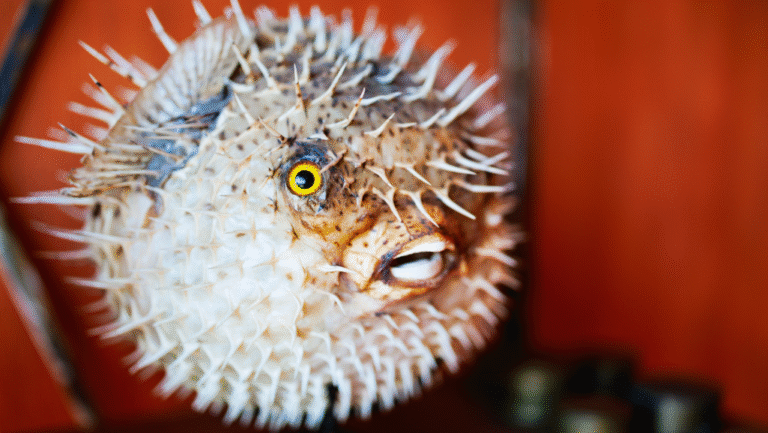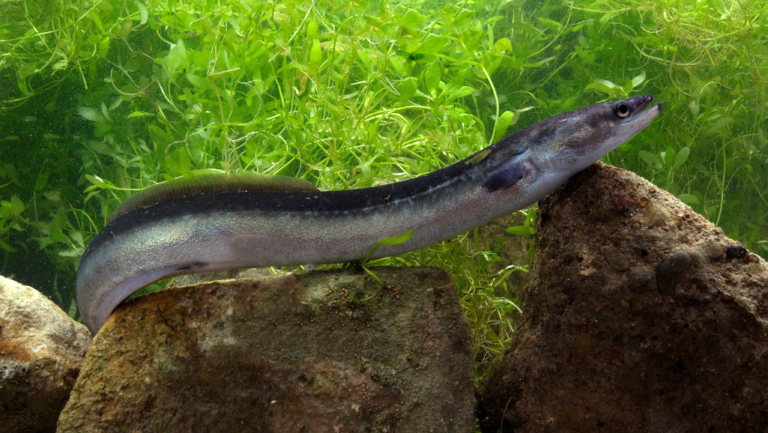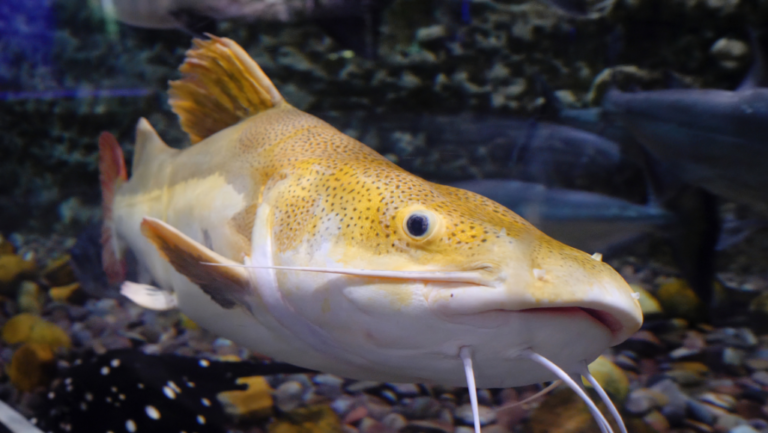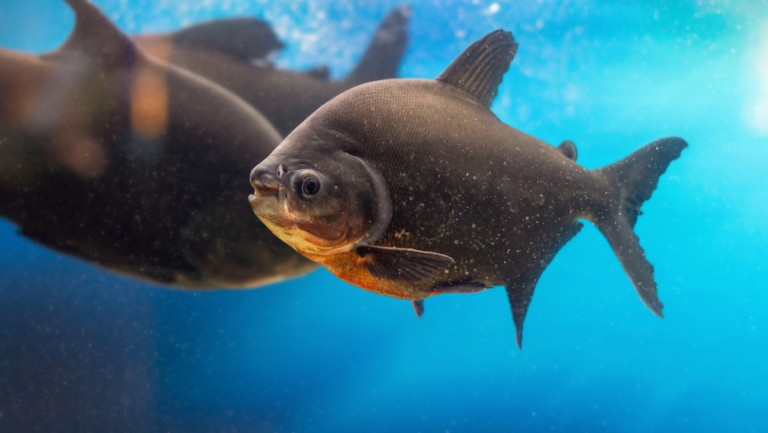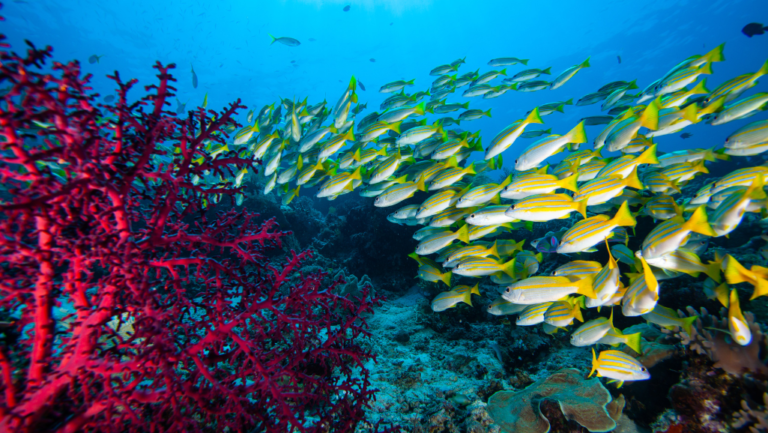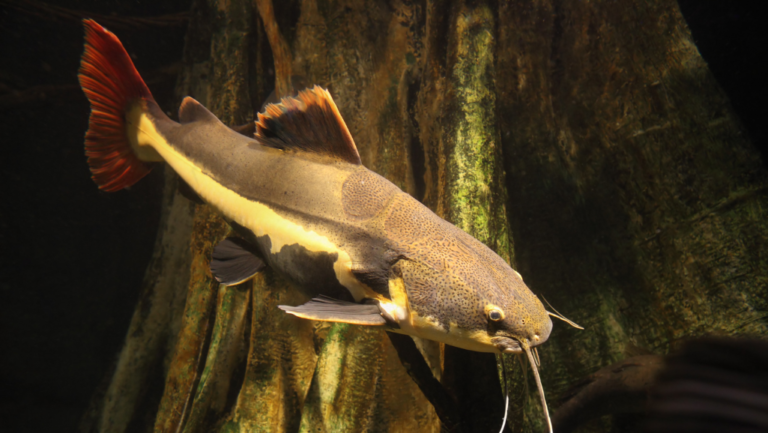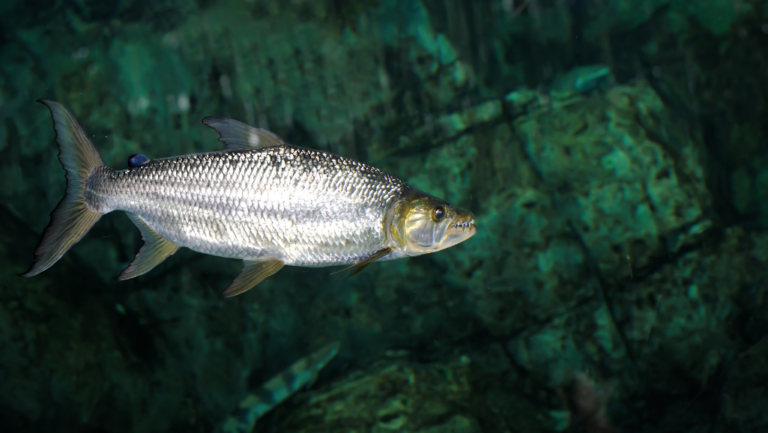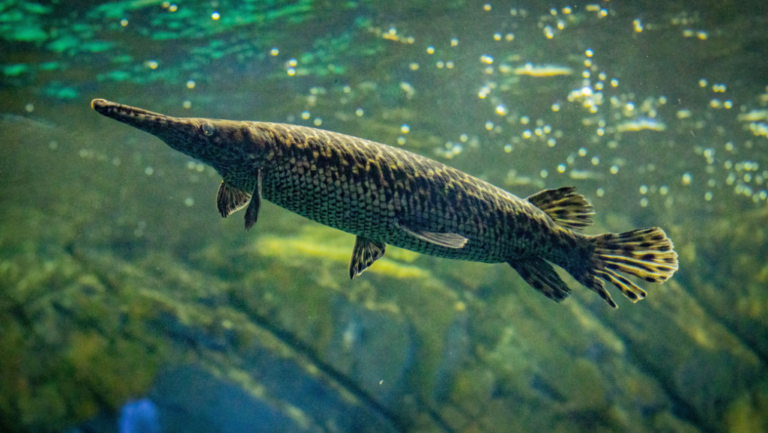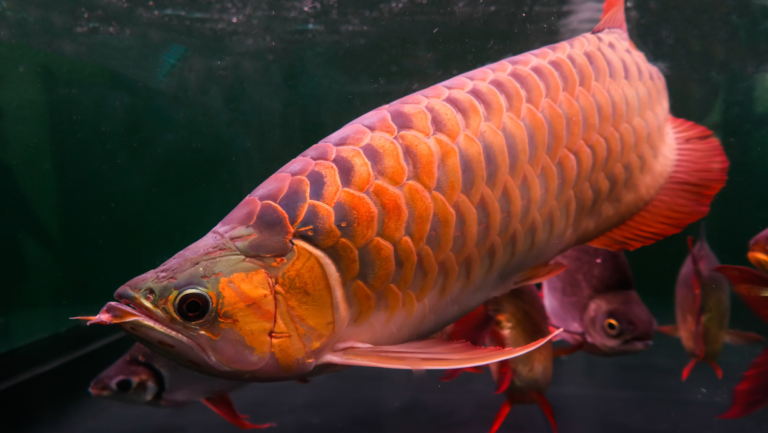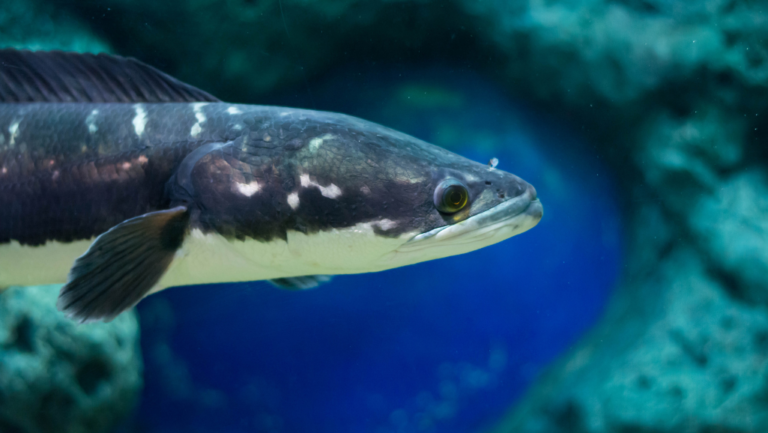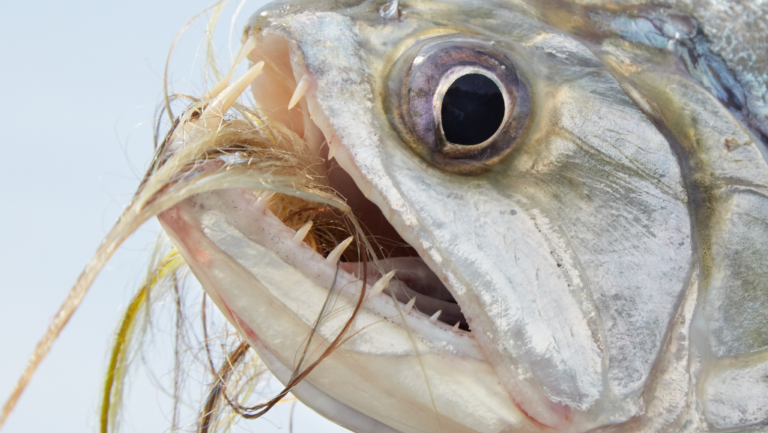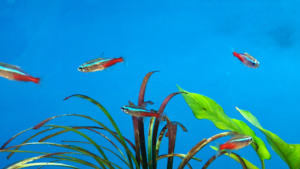In South America’s lush waterways, the Arapaima reigns as a freshwater giant. Known as the Amazon’s behemoth, these fish can grow up to 15 feet long and weigh 440 pounds. They are celebrated for their size and unique ability to breathe air, thanks to a modified swim bladder.
At the Smithsonian National Zoo’s Amazonia exhibit, visitors can see Arapaimas up close. The exhibit is designed to mimic their natural habitat. Here, these Amazonian giants swim gracefully, showing off their massive size. They are a living link to the past, with fossils dating back over 13 million years.
Key Takeaways:
- Arapaimas are one of the most colossal freshwater giants, capable of growing up to 15 feet and weighing up to 440 pounds.
- Their modified swim bladder permits them to breathe air, classifying them as obligate air breathers.
- A diverse diet sustains the Arapaima, consuming fish, fruits, seeds, insects, and more, showing their “gulper” feeding strategy.
- With a rich history extending over 13 million years, the Arapaima’s evolution and adaptations make them a study of ancient endurance.
- Facing threats such as overfishing and habitat loss, conservation initiatives are vital for Arapaima survival, with efforts by the Smithsonian’s scientists.
Overview of Arapaima and Its Habitat
The Arapaima is a giant freshwater fish from the Amazon River basin. It has unique traits that show its ancient origins. Found in South America’s floodplains, the Arapaima’s habitat is vast and dynamic.
Natural Habitat and Distribution
The Arapaima lives in slow-moving waters and seasonal floodplain lakes of the Amazon River basin. These places are perfect for their survival and growth. They need shallow waters rich in oxygen to breathe air through their special labyrinth organ.
Size and Lifespan
Arapaimas are truly massive. They can grow up to 3.07 meters long and weigh 200 kilograms. Some are even reported to be up to 4.57 meters long. Despite their size, they live a long life, making them top predators in their ecosystems.
Physical Characteristics
Arapaimas have a streamlined body and a copperish-green head. Their upturned mouth is perfect for feeding on the surface. They have a mix of black, white, and red colors, helping them blend in and stand out in the Amazon’s murky waters.
Knowing about Arapaima’s size, lifespan, and looks helps us understand their role in the Amazon’s ecosystem. This knowledge is key for protecting these amazing creatures and their habitat.
Importance of Arapaima in Amazonian Ecosystem
The giant Arapaima is key to the Amazon’s balance. It’s a top freshwater fish, playing a big role in keeping the ecosystem in check. Its predatory role and how it interacts with other species are vital.
In the Amazon River, Arapaima thrives. It can grow over three meters long. This fish is not just a top predator but also boosts the area’s biodiversity.
Role as a Predator
Arapaima’s hunting skills are essential for its survival and the Amazon’s balance. It eats fish, small mammals, and birds. This keeps the ecosystem balanced, preventing any one species from taking over.
Interaction with Other Species
Arapaima does more than hunt. It goes into flooded forests, thanks to its air-breathing ability. This lets it find more food and help spread seeds and plants. It’s a big part of the Arapaima ecosystem.
Arapaima’s presence makes the Amazon a lively place. It shows how connected life is in the Amazon Basin. Each species, including Arapaima, is vital for the ecosystem’s health.
Arapaima in Aquariums and Fish Tanks
Creating the perfect habitat for Arapaima in aquariums and fish tanks is a big challenge. These fish are not just big; they also have unique needs. Knowing what they need helps keep them healthy and happy.
Arapaima tanks must look like their natural home. This means they need a lot of space. The size of the tank is very important.
Ideal Tank Conditions
The best conditions for Arapaima are warm and slightly acidic, like the Amazon. The water should be between 75 and 86 degrees Fahrenheit. The pH level should be between 6.5 and 7.5. Also, the tank must let them easily get air from the surface.
Size Requirements for Arapaima Tanks
Arapaima tanks need to be very big. These fish can grow over 10 feet long. So, the tank should be at least 2000 gallons. It also needs a lot of surface area for them to breathe and grow.
Compatible Fish and Tank Mates
Choosing the right tank mates for Arapaima is important. They are predators and need calm, big fish that like the same water. Large catfish or South American cichlids are good choices. But, you must watch them to make sure they get along.
In short, creating the right environment and choosing the right tank mates is key. It helps Arapaima stay healthy and lets aquarium lovers enjoy them at home.
Feeding Habits of Arapaima
The Arapaima, a top fish in the Amazon, has unique feeding habits. These habits are key to their survival and role in the ecosystem. As they grow, their diet changes from small fish to larger prey.
Diet in the Wild
Studies in the middle Juruá River show the Arapaima’s diet changes with age and season. Young Arapaimas eat fish and invertebrates, needing protein for growth. Adults eat many fish species and sometimes even eat their own kind.
Feeding in Captivity
Keeping Arapaima healthy in captivity is hard. They need a balanced diet of herring, squid, and special gels. This diet helps meet their diverse needs in aquariums without natural food.
Nutritional Requirements
Knowing how Arapaima eat and what they need is fascinating and important. A diet close to their natural one keeps them healthy. This helps mimic the Amazon’s ecosystem in captivity.
Learning from local fishermen and studies helps us care for Arapaima. Understanding their Arapaima diet is vital for their management and conservation.
Conservation Status of Arapaima
The Arapaima gigas is a huge fish in the Amazon. It faces many dangers. These dangers include pollution, habitat loss, and being caught for pets.
Threats to Natural Populations
Overfishing and habitat loss are big problems. The arapaima is protected by CITES Appendix II. This means trade needs to be controlled to save it.
Logging and farming cut down its home. Non-native species also compete with arapaima. This messes up the balance of nature.
Conservation Efforts
People and scientists are working to save the arapaima. In some places, their numbers have gone up by 600%. This is thanks to good fishing and protecting their homes.
Scientists use special ways to count arapaima. This helps make plans to keep them safe for the future.
Importance of Sustainable Practices
Good practices are key for arapaima survival. Rules like no fishing zones and limits on catching help. This keeps the ecosystem balanced and supports local people.
In São Raimundo, only 30% of arapaima can be caught. This protects the young and helps the population grow. It’s a great example of how to keep things sustainable.
It’s important to follow these rules for the Amazon’s water life. Helping to save the arapaima also protects the Amazon’s unique nature. It shows how important it is to use sustainable ways to live.
Breeding Arapaima in Captivity
Breeding Arapaima in a controlled setting is both exciting and challenging. It’s important to mimic their natural habitat and meet their biological needs. This is key for successful captive reproduction.
Breeding Challenges
Arapaima’s breeding habits are both fascinating and complex. They are mouth brooders, with the male carrying eggs until they hatch. Captive breeding requires specific conditions to mimic this behavior.
They reach sexual maturity at around 8 feet, needing large enclosures and precise water conditions. This encourages natural breeding behaviors.
Breeding Methods
To breed Arapaima, aquarists mimic the Amazon’s seasonal changes, mainly the rainy season. The male builds a nest and has a sticky membrane on its head for the fry. Replicating these behaviors in captivity is essential and requires careful tank conditions and expert care.
Fry Care and Growth
Proper fry management is vital for young Arapaima’s growth and health. They need a varied diet, from insects to mollusks, based on their age. Maintaining water quality and temperature is critical, as their lower lethal temperature is around 16°C.
Adult Arapaima need a lot of space, ideally a three-hectare lake for every three fish. This makes breeding them a challenge for only the most dedicated and well-equipped aquarists.
In conclusion, breeding Arapaima in captivity is challenging but rewarding. It helps us understand their complex lifecycle and behaviors. This journey from egg to adult in captivity supports conservation and deepens our knowledge of these Amazon giants.
Cultural Significance of Arapaima
The Arapaima gigas, known as a giant freshwater fish, holds deep cultural significance in the Amazon. It connects with indigenous traditions and local economies. This fish’s importance is seen in its size, history, and role in local economies.
Historical Uses by Indigenous Peoples
For centuries, the Arapaima has been vital to Amazonian communities. Known as ‘pirarucu’ in Brazil and ‘paiche’ in Peru, it’s more than just food. Indigenous people have learned to preserve it, showing their deep understanding of the environment.
These preservation methods are now seen in modern cooking, showing the fish’s lasting impact. It remains a key part of indigenous traditions and food.
Role in Local Economies
In recent years, the Arapaima has become important for local and regional economies. The Mamirauá Reserve is a great example. It allows legal fishing, helping local families and supporting conservation.
The Arapaima’s role goes beyond fishing. It affects eco-tourism, sustainable fishing, and global trade.
The Arapaima’s impact is vast, from the environment to the economy. These fish support local economies and teach us about sustainability and respect for culture. The Arapaima’s story shows the balance between nature and culture, evolving yet staying true to tradition.
Keeping Arapaima as a Pet
Arapaima are huge and impressive, making them a dream for many fish lovers. They are the biggest freshwater fish in the world. Keeping them as pets means big responsibilities and strict laws.
These fish can grow up to 15 feet long in the wild. Even in captivity, they don’t get much smaller, reaching up to 23.62 inches. It’s a big challenge to care for such large fish at home. You need to know a lot about their care and the laws about owning them.
Legal Considerations
There are strict rules about owning Arapaima. They are listed as Data Deficient on the IUCN Red List and are on CITES Appendix II. It’s important to follow these laws to protect these fish from harm.
Necessary Experience and Commitment
Arapaima need a very big tank or pond to live in. You’ll need at least a 1,000-gallon tank. Sometimes, they are kept in tanks up to 10,000 gallons in public aquariums.
Before getting an Arapaima, you must show you can handle the big tank. They need a lot of space and air to breathe. They must be able to get to the surface every 20 minutes.
General Care Guidelines
These fish need a strong filter and regular water changes. You should change 15-20% of the water every week. They like warm water, between 75.0 to 84.0°F.
They eat a lot of protein, so finding the right food is key. For those who love vibrant aquariums, there are tips to help. Caring for an Arapaima is more than just a pet. It’s a big commitment to keep a piece of the Amazon alive in your home.
